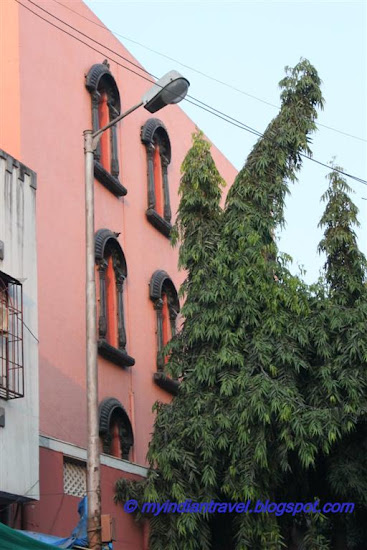Pancha Rathas are group of important monuments in Mahabalipuram. These 7th century shrines were carved sometime in the period 630 - 670 A.D. during the reign of King Narasimhavarman I. There are totally five shrines, each of them are monolith, carved out from an outcropping of rock.
 Since these temples are still unfinished, no worship has been offered there. Pancha Rathas when translated mean "five chariots", and they are named individually after Draupadi and the Pandava brothers. It is different matter that there may not be relation between them and the epic Mahabharata.
Since these temples are still unfinished, no worship has been offered there. Pancha Rathas when translated mean "five chariots", and they are named individually after Draupadi and the Pandava brothers. It is different matter that there may not be relation between them and the epic Mahabharata.
 The view in this photo is from the northwest. In the foreground is a carved lion. Behind the lion, from left to right in the photo, are the Draupadi, Arjuna, and Bhima Rathas. In front of Bhima Ratha is Elephant and Nakul-Sahadava Ratha. Dharmaraja Ratha is hidden in this photo behind the other structures.
The view in this photo is from the northwest. In the foreground is a carved lion. Behind the lion, from left to right in the photo, are the Draupadi, Arjuna, and Bhima Rathas. In front of Bhima Ratha is Elephant and Nakul-Sahadava Ratha. Dharmaraja Ratha is hidden in this photo behind the other structures.
 Draupadi Shrine is the smallest and simplest and it is formed as a bangla hut. The Arjuna shrine is like a small palace or pavillion, with sculpted pilasters, and an octagonal dome. Bhima Shrine is the largest with its barrel vaulting and long columned porch. Seated lions are carved in front of the columns at the base. Nakul-Sahadeva Shrine is south-facing and is in apsidal shape.
Draupadi Shrine is the smallest and simplest and it is formed as a bangla hut. The Arjuna shrine is like a small palace or pavillion, with sculpted pilasters, and an octagonal dome. Bhima Shrine is the largest with its barrel vaulting and long columned porch. Seated lions are carved in front of the columns at the base. Nakul-Sahadeva Shrine is south-facing and is in apsidal shape.
 Dharmaraja Shrine is a larger version of the Arjuna Shrine with pyramidal roof. The building is topped by an octagonal-shaped dome, the shikhara. Since there is a increase in the elevation below this shrine, it gives a clear look at the decorative elements of its roof, when compared with Arjuna's similar roof.
Dharmaraja Shrine is a larger version of the Arjuna Shrine with pyramidal roof. The building is topped by an octagonal-shaped dome, the shikhara. Since there is a increase in the elevation below this shrine, it gives a clear look at the decorative elements of its roof, when compared with Arjuna's similar roof.
The craftsmanship when viewed in person will be appreciated more.
 We would have missed seeing this temple, had I not followed a group of travelers going in the direction of the rocks. I am glad I followed them.
We would have missed seeing this temple, had I not followed a group of travelers going in the direction of the rocks. I am glad I followed them. This 7th century rock-cut shrine is unique in that is honors the Hindu Trinity in one place. This cave temple is devoted to three supreme gods of Hindus, Brahma-the creator, Vishnu-the preserver and Shiva-the destroyer.
This 7th century rock-cut shrine is unique in that is honors the Hindu Trinity in one place. This cave temple is devoted to three supreme gods of Hindus, Brahma-the creator, Vishnu-the preserver and Shiva-the destroyer. There is a separate section in the temple for each of them.
There is a separate section in the temple for each of them.


























